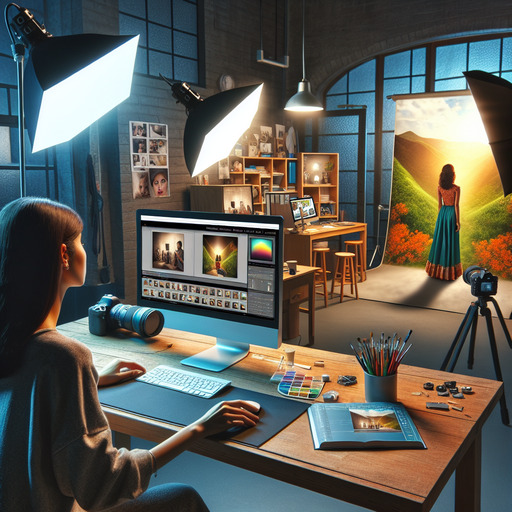
-
Table of Contents
Discover the Essential Lighting Techniques for Photography to elevate your skills and capture stunning images! Learn More
Introduction
Essential lighting techniques are fundamental to the art and science of photography, shaping the mood, tone, and clarity of an image. Mastering these techniques allows photographers to manipulate light to their advantage, whether working with natural sunlight or artificial sources. Key methods include understanding the quality, direction, and color of light, as well as employing tools like reflectors, diffusers, and various types of lighting setups such as three-point lighting, backlighting, and side lighting. By skillfully applying these techniques, photographers can enhance texture, depth, and dimension, ultimately creating compelling and visually striking photographs.
Mastering Essential Lighting Techniques for Professional Photography: Tips for Portraits, Landscapes, and Editing
Mastering essential lighting techniques is crucial for any photographer aiming to elevate their work to a professional level. Whether you are capturing portraits, landscapes, or fine-tuning your images during the editing process, understanding how to manipulate light can make a significant difference in the quality of your photographs. To begin with, let’s delve into the realm of portrait photography, where lighting plays a pivotal role in highlighting the subject’s features and setting the mood of the image.
In portrait photography, one of the most fundamental lighting techniques is the use of natural light. Positioning your subject near a window or in an outdoor setting during the golden hour—shortly after sunrise or before sunset—can produce soft, flattering light that enhances skin tones and adds a natural glow. However, when natural light is not available or sufficient, artificial lighting becomes indispensable. Utilizing tools such as softboxes, reflectors, and diffusers can help control the intensity and direction of light, thereby reducing harsh shadows and creating a more balanced exposure.
Transitioning to landscape photography, the principles of lighting shift slightly. Here, the goal is often to capture the grandeur and beauty of natural scenes. The quality of light can dramatically alter the appearance of a landscape, making it essential to understand the different types of natural light and their effects. For instance, the golden hour is also highly beneficial for landscapes, casting long shadows and warm hues that add depth and dimension to the scene. Conversely, the blue hour, which occurs just before sunrise and after sunset, offers a cooler, more ethereal light that can create a serene and mystical atmosphere.
Moreover, mastering the use of filters, such as polarizers and neutral density filters, can further enhance your landscape photography. Polarizers help reduce glare and enhance colors, making skies appear more vibrant and water more transparent. Neutral density filters, on the other hand, allow for longer exposure times, enabling you to capture motion in elements like waterfalls or clouds, adding a dynamic quality to your images.
As we move into the editing phase, the importance of lighting continues to be paramount. Post-processing software like Adobe Lightroom and Photoshop offers a plethora of tools to adjust and enhance the lighting in your photographs. Techniques such as dodging and burning can be used to selectively lighten or darken areas of an image, thereby adding contrast and guiding the viewer’s eye to the focal points. Additionally, adjusting the white balance can correct color casts and ensure that the colors in your image are true to life.
Furthermore, understanding the histogram—a graphical representation of the tonal values in your image—can help you make informed decisions about exposure adjustments. A well-balanced histogram typically indicates a well-exposed image, with details preserved in both the highlights and shadows. By mastering these editing techniques, you can refine the lighting in your photographs, ensuring that the final image is polished and professional.
In conclusion, mastering essential lighting techniques is a multifaceted endeavor that spans from the initial capture to the final edit. Whether you are working with natural or artificial light, shooting portraits or landscapes, or fine-tuning your images in post-processing, a deep understanding of how to manipulate light will significantly enhance the quality of your photography. By continually practicing and experimenting with different lighting setups and editing tools, you can develop a keen eye for light and create stunning, professional-quality images.
Q&A
1. **What are some essential lighting techniques for photography?**
– **Three-Point Lighting:** Utilizes key light, fill light, and back light to create depth and dimension.
– **Natural Light:** Leveraging sunlight, often diffused through windows or clouds, for a soft, natural look.
– **Rembrandt Lighting:** Characterized by a small, triangular highlight on the cheek opposite the light source, creating a dramatic effect.
– **Butterfly Lighting:** Places the key light directly in front and above the subject, creating a butterfly-shaped shadow under the nose.
– **Split Lighting:** Illuminates one side of the subject’s face, leaving the other in shadow, for a high-contrast, dramatic effect.
– **Loop Lighting:** Creates a small shadow of the subject’s nose on their cheek, providing a natural and flattering look.
– **Broad Lighting:** The side of the face turned towards the camera is lit, making the face appear wider.
– **Short Lighting:** The side of the face turned away from the camera is lit, making the face appear narrower.
– **High-Key Lighting:** Uses bright, even lighting to reduce shadows and create a light, airy feel.
– **Low-Key Lighting:** Employs strong contrasts and deep shadows for a moody, dramatic effect.